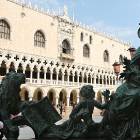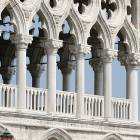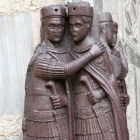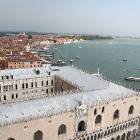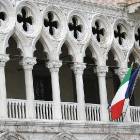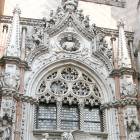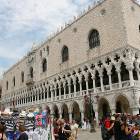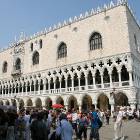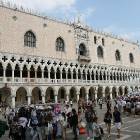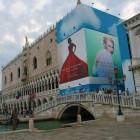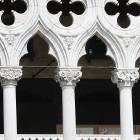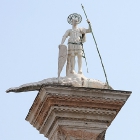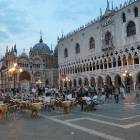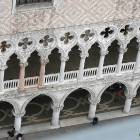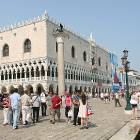Doge’s Palace, the splendor of Venetian Gothic
This palace is almost glued to St Mark’s Basilica, the only building that surpasses it in beauty and fame in the city on the lagoon. Doge’s Palace has on its side the advantage of being right next to the canal, which gives it an even more poetic look and emphasizes the floating effect that the two rows of columns bellow give to the superior enclosed walls.
Indeed, in an age when castles served as fortresses, the Venetians used the advantage of having a city surrounded and defended by waters, to build an unusual open residence for the “dark” Middle Ages. The works at this palace started right in the beginning of the 14 century, somewhere around 1301 and 1309. It took 150 years to complete the interior and all the wings of the palace.
The doge was the elected ruler of Republic of Venice, who held this magistrature for the rest of his life. The doge held absolute, but not tyrannical power, being allowed to govern by only due to a mandate given by the upper class. There were two sources of inspiration for the Venetian political system: the ancient Roman republic, with its later age dictators, and the Byzantine Empire, from which Venetians borrowed the idea of intertwining secular and religious power of the ruler. The political system of Venice was emulated over the Adriatic Sea, in the Republic of Rangusa (today, Dubrovnik), who shared the same pride of being a republic of the free. It’s not surprising that the equivalent institution to the Doge, the Rector, had a resembling palace there.
When Doge’s Palace was built, some centuries after the fall of Constantinople, Venice was the richest city of Europe. It was largely an aristocracy, meaning the reach and noble class governed through pyramid like institutions, with a senate of 2-300 hundred, a council of 10, of which a doge was chosen. The term itself is reminiscent of the Roman Dux (Duke) from which it was inspired.
The beauty of Doge’s Palace is given by the two rows of vaulted space supported by thin columns. The Byzantine decorative art of the capitals of these columns, mixed with the Gothic shape of the pointed arch, created a local style known as Venetian Gothic. The capitals are carved in stone with Biblical scenes. The superior rows of the facade are closed and covered with white and pinkish marble, arranged as to form a decorative pattern. Only austere windows break the surface of this outside wall. The decorative exuberance of Venetian Gothic returns at the roof part, adorned with statues and stone carvings.
The art of the stonemasons is visible especially in the monumental gates, in the marble ladder inside and in the enclosed bridges that cross over the canal. The most famous of these bridges is the Bridge of Sighs, that used to connect the tribunal with the prison cells found in the underground of the palace. The legend had it that this used to be the route taken by those condemned, who would take a last glimpse of the beautiful city through the carved small windows of the bridge. Ironically, the same bridge is present in romantic superstitions, supposedly assuring happiness to couples kissing bellow it, in a gondola.
During the time of the Doges, the palace used to be on a higher ground, with some steps before the columns, but successive pavings of Piazzetta San Marco leveled the ground. Inside the palace there is now a museum that holds important works of art, including some of the most valuable Renaissance paintings by Titian.
A column with a statue of St George killing the dragon is found next to the palace, in the small plaza, that is connected with the main city square, in front of St Mark’s Cathedral.
- Home Page
start page - Architecture
landmark buildings - Sacred architecture
places of worship - Nature
landscape photography - Concert
performing artists - Christmas
Santa Claus pictures
- Jooble
jobs for photographers - Escape
an out of control blog - Merry Christmas
The best organizer of Christmas parties - Astro photo
Eclipse hunting and astrological photography

